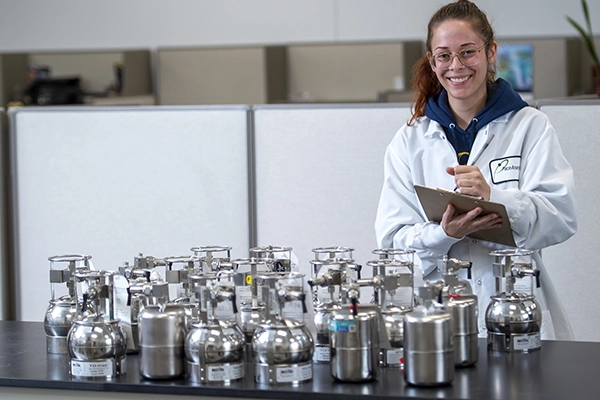Your Experts In Indoor Air Quality Analysis
Did you know that an average person takes 12-16 breaths per minute? It’s essential to be aware of the quality of the indoor air. Various sources of contaminants, like fuels, mold, solvents, cleaning products, and VOCs from construction materials, can affect indoor air quality. Pace® offers comprehensive testing services for these contaminants and many others to ensure a safe and healthy environment.
Here are just a few of the ways we’ve set the pace for indoor air quality testing.
Indoor Air Quality Monitoring And Testing
Monitoring indoor air quality is essential to keeping employees, customers, and the general public safe. Here are a few of the more common types of indoor air quality analyses Pace® performs for customers.

Dust is often a serious issue in certain industrial settings. It can affect our sinuses, lungs, and entire respiratory system. Prolonged exposure to dust is one of the most serious risks to industrial safety. This is because the human body doesn’t have effective defenses to cope with the internal accumulations of foreign particles that attack the respiratory and skin systems.
Understanding the differences between dust particles and the latest dust measurement and sampling methods are essential to maintaining a safe and healthy working environment.
IAQ Microbial Testing is used to identify bacteria and fungi and their concentrations in the indoor environment. It is often used for environmental investigations after an event and to validate effective remediation. These analyses include bacterial and fungal cultures, counts, identification, and speciation in air.
Toxic metals are individual metals or metal compounds that negatively affect human health through exposure over time. Industrial processes, combustion of fossil fuels, vehicle exhaust, and waste incineration are the main anthropogenic sources of metal emissions. Mercury, lead, chromium, cadmium, and arsenic are the most common metals implicated in human poisoning.
Contamination is often found during remediation or re-development of sites where metals have been used, stored, or disposed. Exposure may come from both dust and aerosols created during on-site cleanup activities. Metals are tested by collecting and analyzing particulates, a component of dust in the air.
Mold spores are not visible to the naked eye and are found everywhere. When mold spores land on surfaces that are wet, mold may begin growing indoors. As molds sporulate, they continue to multiply on the surface.
There are two main tests for mold: viable and non-viable. Non-viable tests (also known as spore traps) are the industry standard for residential mold testing. In non-viable testing, an air sample is collected and observed directly under a microscope. No culturing is required so results are ready quickly. In viable testing, a sample of air is taken on a growth media and incubated in a petri dish until colonies form. This process helps identify the exact species and can determine exposure to various toxic molds.
Semi-volatile organic compounds (SVOCS) are chemically similar to other VOCs with carbon-based molecular structures. They are present both as a gas or adsorbed to indoor materials and the surfaces of airborne particles. Flame retardants, plasticizers, and pesticides are examples of indoor sources of SVOCs. Other semi-volatile compounds include Perfluoroalkyl acids (PFAAs), Phthalates, PCBs (also known as Aroclors), and PAHs.
Volatile organic compounds, or VOCs, are vapors or gases containing carbon and are volatile by nature. Indoor VOCs are present partly as gaseous airborne chemicals and partly as chemicals adsorbed on indoor surfaces and onto microscopic airborne and settled particles. Many products found in buildings naturally emit VOCs. They are found in paints, cleaners, stored fuels, wood preservatives, building materials, furnishings, office equipment, disinfectants, and more.
VOCs are probably the most common contaminant in office and industrial settings. Long-term exposure can cause damage to the nervous system, liver, and kidneys. Short-term exposure can contribute to respiratory problems, headaches, allergic skin reactions, nausea, and dizziness. Children, pregnant woman, and their unborn babies are particularly sensitive to VOCs.
Indoor Air Quality Testing Services
The United States Environmental Protection Agency (EPA) and many states set limits on the level of contaminants allowable in the nation’s air. Protecting public health and mitigating risk requires fast, reliable testing services with defensible results. Pace® has provided indoor air testing and analysis services for more than three decades. Our testing services include:
- Dioxin Furans
- Mold
- PCBs
- PAHs
- Source Gases (C1 – C4)
- Total and Respirable Dust
- Volatile Organic Chemicals
Additional Resources
-
Pace® Environmental Certifications
-
Pace® Environmental Emergency Response
-
Related Pages
-
Downloadable Resources
-
On-Demand Webinars
Need to find a lab that can handle your unique requirements?
Contact us directly or download our list of environmental certifications across our network.
When disaster strikes, the Pace® Environmental Emergency Response Team is here to help you act fast.
On-demand Webinar: What You Need to Know, That You Don't Know About TO-15